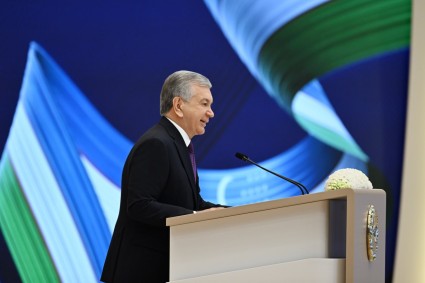Uzbekistan’s permanent population as of July 1, 2024 was 37 million 134.2 thousand people. Thus, since the beginning of the year, the permanent population grew by more than 334 thousand people, and compared to the same period in 2023 - 761.8 thousand people, or 2.1%, the Statistics Agency said in a report.
Among the population, there are 18.7 million men and 18.4 million women. The urban population is more than 18.9 million people, the rural population is 18.2 million people.
The average age of the population is 28.5 years for men, 30 years for women. The average age of the population is an approximate general description of the age composition of the population. It is calculated as the arithmetic mean of the age of all people in the general population.
Among the total number, 32% of the population are younger than working age, 56.4% are of working age, and 11.6% are older than working age.
By age group, the largest share is still those aged 31-59 years - 13.2 million people, followed by the youth (14-30 years) - 9.6 million, children aged 5-13 years - 6.1 million, children under 4 years - 4.3 million and the population aged 60 years and older - 3.4 million people.
Among men, children under five years old made up the largest figure - 2.3 million people, the smallest - 60-64-year-olds, there were 657 thousand of them. Among women, the largest figure was also made up of girls under five years old - 2.1 million people, the smallest number of women was noted in the age group 60-64 years - 736 thousand people.
The report also provided the figure for life expectancy at birth. In 2023, it was 72.5 years for men and 76.9 years for women. While, if the life expectancy of men in the city and in the village is almost the same - 72.6 and 72.3 years, respectively, then for women the difference is one and a half years - 77.5 in the city and 76 in the village.
The population density in Uzbekistan was 82.7 people per square kilometer. This is 1.7 people more if compared with the same period in 2023 (81 people per 1 sq. km as of July 1, 2023). In terms of provinces, the highest population density was 6864.4 people in Tashkent, 796.4 in the Andijan province, 606.3 in the Fergana province. The lowest rates were recorded in the Navoi province - 9.8 and the Republic of Karakalpakstan - 12.1 people.
The largest permanent population by province is 4.25 million people in the Samarkand province, 4.1 million people in the Fergana province, 3.6 million people in the Kashkadarya province. The smallest population is in Syrdarya province - 922.1 thousand people, Navoi province - 1.1 million people and Jizzakh province - 1.5 million people.
Birth rate
The number of live births in January-June was 419.9 thousand children, of which boys - 218.1 thousand, girls - 201.8 thousand. The number of births in urban areas reached 212.3 thousand people, rural areas - 207.6 thousand.
When analyzing the number of births, it is as follows: the birth of one child was 97.7%, two children - 2.2%, three or more children - 0.1%.
Among fathers, 9.9% were under 25 years of age, 82.9% were 25-39 years of age, and 7.2% were 40 years of age and older. The age of mothers of 37.4% of newborns was under 25 years, 61.3% were 25-39 years of age, and 1.3% of infants had mothers 40 years of age and older.
The highest share of births was noted in the Samarkand province - 12%, Fergana province - 11.2%, Kashkadarya province - 10.5%, Andijan province - 9.2%, and Surkhandarya province - 9%.
The birth rate is relatively low in Syrdarya province - 2.5%, Navoi province - 2.9%, Jizzakh province - 4.4%, Khorezm province - 4.5% and Karakalpakstan - 4.5%.
Mortality
The total number of deaths in January-June was 81.4 thousand people, including 44.4 thousand men and 37 thousand women. In cities, the same figures were 46 thousand people, in rural areas - 35.4 thousand.
It should be noted that the number of deaths in the first half of 2024 is higher than in the same periods of the previous nine years, including 2020, 2021 and 2022, which were marked by the coronavirus pandemic.
Among the deaths registered in the first year-half, the main causes were diseases of the circulatory system - 58.4% of cases, tumors - 9.4% of cases, diseases of the respiratory system - 6.6%, accidents, poisoning and injuries - 5.3%, diseases of the digestive system - 4.1%, infectious and parasitic diseases - 1.1%, other diseases - 15.1%.
By province, the highest mortality rate was recorded in Tashkent city - 5.2 ppm, Tashkent province - 5 ppm, the lowest rate was 3.9 ppm in Jizzakh province.
The highest proportion of fatalities was recorded in Samarkand province - 10.9%, Fergana province - 10.4%, Tashkent city - 9.7%, Andijan province - 9.3% and Kashkadarya province - 9.1%.
The proportion of fatalities is relatively small in Syrdarya - 2.5%, Navoi - 2.8%, Jizzakh - 3.6%, Khorezm - 5.2% and Bukhara - 5.4% provinces.
Marriages
The number of registered marriages topped 97.4 thousand, decreasing by 1200 compared to the same period of the previous year. Of these, 50.1 thousand, or 51.4%, were registered in urban areas, 47.3 thousand, or 48.6%, in rural areas.
The average age of women at marriage was 22.9 years, and the average age of men was 27.8 years.
The highest percentage of marriages was in Samarkand province - 10.5%, Kashkadarya province - 10.1%, Fergana province - 10.0%, Tashkent city - 9.2% and Surkhandarya province - 8.3%.
A relatively low share of marriages was in Syrdarya province - 2.5%, Navoi province - 2.7%, Jizzakh province - 3.6%, Bukhara province - 6% and Karakalpakstan - 6.6%.
Divorces
The number of divorces for the first year-half was 22.5 thousand. Over the past four years, their average number has increased significantly. Of the total number of divorces, 13.8 thousand were registered in cities (61.6%), and 8,600 in rural areas (38.4%).
The number of divorces of couples without children was 10.5 thousand cases, with one child - 6,616 cases, with two or more children - 5,372 cases. The average age of divorced men was 37.1 years, women - 32.2 years.
The highest percentage of divorces was 13.1% in Tashkent, 10.6% in the Andijan province, 10.5% in the Fergana province, 10.2% in the Tashkent province and 10.1% in the Samarkand province.
The number of divorces is relatively small in Navoi - 2.6% of the total number of divorces, Syrdarya - 3.4%, Jizzakh - 3.7%, Karakalpakstan - 4% and Khorezm province - 4.4%.
Migration
Over the past six months, 116.6 thousand people arrived in Uzbekistan, including 50.7 thousand men and 65.9 thousand women. The number of those arriving in urban areas reached 87 thousand, and 29.6 thousand people in rural areas.
The largest share of those arriving for permanent residence in Uzbekistan from abroad (in % of their total number) is from the Russian Federation (36.1%) and Kazakhstan (24.1%). 10.7% of arrivals were from Tajikistan, 7.2% - from Kyrgyzstan, 2% - from Turkmenistan, and 19.9% вАЛвАЛfrom other countries.
By age group: 10.8% of those arriving were under working age, 81.7% were of working age, and 7.5% were over working age.
The largest share of immigrants was in Tashkent (38.2%), Tashkent province (13.3%), Samarkand province (6.1%), Navoi province (5.1%), and Kashkadarya province (4.9%).
The number of people leaving Uzbekistan over the past six months was 120.6 thousand people, including 52.8 thousand men and 67.8 thousand women. Those leaving cities topped 83.9 thousand people, and 36.7 thousand people from rural areas.
By age group: 11.2% of those leaving were under working age, 81% were of working age, and 7.8% were over working age.
The largest share of those who left Uzbekistan for permanent residence in foreign countries falls on Kazakhstan (81.5%), followed by the Russian Federation (15%), Kyrgyzstan (0.7%), South Korea (0.7%), Turkmenistan (0.3%), and other countries (1.8%).
The largest share of those who left falls on Tashkent - 29.5%, Tashkent province - 11.5%, Kashkadarya province - 7.3%, Samarkand province - 6.7%, and Karakalpakstan - 6%.
Their share is relatively small in Namangan province - 2.2%, Syrdarya province - 3.2%, Jizzakh province - 3.7%, Andijan province - 3.7%, and Bukhara province - 5%.











